Improvement of Blocked Long-Straight Flow Channels in Proton Exchange Membrane Fuel Cells Using CFD Modeling, Artificial Neural Network, and Genetic Algorithm
Abstract
1. Introduction
2. Model Development
2.1. Geometric Model
2.2. Mathematical Model
2.2.1. Key Physicochemical Parameters
2.2.2. Governing Equations
- Mass conservation equation
- Momentum conservation equation
- Energy conservation equation
- Species conservation equation
- Charge conservation equation
- Liquid water formation and transport equation [29]
- (1)
- Laminar and incompressible flow in flow channels.
- (2)
- Steady conditions of operating PEMFC.
- (3)
- Reactive gases as ideal gas.
- (4)
- Homogeneous porous medium.
- (5)
- Neglected gravity.
3. Results
3.1. Optimization Process
3.1.1. Numerical Calculation
3.1.2. Validation and Grid Independence Test
3.1.3. Object of Optimization
3.1.4. Design of the Database for Training
- Determine N, the sample number of the database.
- Divide the interval from 0 to 1 into N equal parts.
- Select a random value in every part of the interval from 0 to 1.
- Map the selected value to the sample of standard normal distribution (SND) by the inverse function of SND.
3.1.5. ANN Surrogate Models
3.1.6. Single-Objective Optimization
3.2. Comparison and Analysis
4. Discussion
5. Conclusions
- A flow channel model with trapezoidal baffle was suggested, and a 3D and multi-phase CFD model of the PEMFC was established. The ANN method was used to train the surrogate model, and the single-objective optimization method was used to optimize the geometric parameters of the trapezoidal baffle, and the CFD model and the ANN model were verified, respectively.
- The velocity, pressure, and oxygen distribution in the straight flow channel model, rectangular baffle model, and the optimized trapezoidal baffle model were analyzed, and the results showed that the optimized trapezoidal baffle model can effectively improve the transport of oxygen towards the GDL. With voltage at 0.3 V, the power density of the optimized model was 4.0% higher than that of the straight flow channel model, and the pressure drop was only 37.83% that of the rectangular baffle model. The optimized trapezoidal baffle model showed better performance than the straight flow channel model and less pressure drop than the rectangular baffle model.
- The PEMFC had its highest power output with a voltage of 0.4 V. The rectangular baffle model with higher power density can achieve higher net power output than the trapezoidal baffle model, even with relatively high pump power requirements. However, for on-road PEMFC with 0.6 V voltage, the influence of pump power was significant, and the optimized trapezoidal baffle model had a net power increase of 1.47% compared to the rectangular baffle model at 50% pump efficiency and 3.94% at 30% pump efficiency. The performance of the optimized trapezoidal baffle model surpassed that of the other two models in practical application.
Author Contributions
Funding
Institutional Review Board Statement
Informed Consent Statement
Data Availability Statement
Conflicts of Interest
Nomenclature
| Symbol | Units | Description |
| H | mm | Attitude of trapezoidal baffles |
| Lf | mm | Length difference between two bases |
| ε | - | Porosity |
| ρ | kg/m3 | Density |
| p | Pa | Pressure |
| S | Source term | |
| ϕ | V | Potential |
| M | g/mol | Molar mass |
| F | C/mol | Faraday constant |
| i | A/cm2 | Exchange current density |
| μ | Pa·s | Dynamic viscosity |
| cp | J/(kg·K) | Specific heat at constant pressure |
| Pnet | W/cm2 | The net power density |
| R2 | - | Coefficient of determination |
| Subscripts | ||
| Symbol | Description | |
| an | Anode | |
| ca | Cathode | |
| u | Momentum | |
| ohm | Ohmic | |
| Acronyms | ||
| Symbol | Description | |
| PEMFC | Proton Exchange Membrane Fuel Cell | |
| LBM | Lattice Boltzmann method | |
| EIS | Electrochemical Impedance Spectroscopy | |
| ANN | Artificial Neural Network | |
| GA | Genetic Algorithm | |
| MOO | Multi-Objective Optimization | |
| GDL | Gas Diffusion Layer | |
| CL | Catalyst Layer | |
| BP | Bipolar Plate | |
| MEA | Membrane Electrode Assembly | |
| MSE | Mean Square Error | |
| LHS | Latin Hypercube Sampling | |
References
- Barbir, F.; Yazici, S. Status and development of PEM fuel cell technology. Int. J. Energy Res. 2008, 32, 369–378. [Google Scholar] [CrossRef]
- Manoharan, Y.; Hosseini, S.E.; Butler, B.; Alzhahrani, H.; Senior, B.T.F.; Ashuri, T.; Krohn, J. Hydrogen Fuel Cell Vehicles; Current Status and Future Prospect. Appl. Sci. 2019, 9, 2296. [Google Scholar] [CrossRef]
- Wang, Y.; Diaz, D.F.R.; Chen, K.S.; Wang, Z.; Adroher, X.C. Materials, technological status, and fundamentals of PEM fuel cells—A review. Mater. Today 2020, 32, 178–203. [Google Scholar] [CrossRef]
- Ijaodola, O.S.; El-Hassan, Z.; Ogungbemi, E.; Khatib, F.N.; Wilberforce, T.; Thompson, J.; Olabi, A.G. Energy efficiency improvements by investigating the water flooding management on proton exchange membrane fuel cell (PEMFC). Energy 2019, 179, 246–267. [Google Scholar] [CrossRef]
- Jiao, K.; Li, X. Water transport in polymer electrolyte membrane fuel cells. Prog. Energy Combust. Sci. 2011, 37, 221–291. [Google Scholar] [CrossRef]
- Wang, X.R.; Ma, Y.; Gao, J.; Li, T.; Jiang, G.Z.; Sun, Z.Y. Review on water management methods for proton exchange membrane fuel cells. Int. J. Hydrogen Energy 2020, 46, 12206–12229. [Google Scholar] [CrossRef]
- Lin, R.; Ren, Y.S.; Lin, X.W.; Jiang, Z.H.; Yang, Z.; Chang, Y.T. Investigation of the internal behavior in segmented PEMFCs of different flow fields during cold start process. Energy 2017, 123, 367–377. [Google Scholar] [CrossRef]
- Pei, H. Study on Water And Heat Management of PEMFC. Ph.D. Thesis, Huazhong University, Wuhan, China, 2014. [Google Scholar]
- Wang, L.; Husar, A.; Zhou, T.; Liu, H. A parametric study of PEM fuel cell performances. Int. J. Hydrogen Energy 2003, 28, 1263–1272. [Google Scholar] [CrossRef]
- Hakenjos, A.; Muenter, H.; Wittstadt, U.; Hebling, C. A PEM fuel cell for combined measurement of current and temperature distribution, and flow field flooding. J. Power Sources 2004, 131, 213–216. [Google Scholar] [CrossRef]
- Nandjou, F.; Poirot-Crouvezier, J.-P.; Chandesris, M.; Blachot, J.-F.; Bonnaud, C.; Bultel, Y. Impact of heat and water management on proton exchange membrane fuel cells degradation in automotive application. J. Power Sources 2016, 326, 182–192. [Google Scholar] [CrossRef]
- Sakaida, S.; Tabe, Y.; Chikahisa, T. Large scale simulation of liquid water transport in a gas diffusion layer of polymer electrolyte membrane fuel cells using the lattice Boltzmann method. J. Power Sources 2017, 361, 133–143. [Google Scholar] [CrossRef]
- Shao, Y.; Xu, L.; Li, J.; Hu, Z.; Fang, C.; Hu, J.; Guo, D.; Ouyang, M. Hysteresis of output voltage and liquid water transport in gas diffusion layer of polymer electrolyte fuel cells. Energy Convers. Manag. 2019, 185, 169–182. [Google Scholar] [CrossRef]
- Shao, Y.; Xu, L.; Li, J.; Ouyang, M. Numerical modeling and performance prediction of water transport for PEM fuel cell. Energy Procedia 2019, 158, 2256–2265. [Google Scholar] [CrossRef]
- Zhao, J.; Li, X. Oxygen transport in polymer electrolyte membrane fuel cells based on measured electrode pore structure and mass transport properties. Energy Convers. Manag. 2019, 186, 570–585. [Google Scholar] [CrossRef]
- Peng, Y.; Mahyari, H.M.; Moshfegh, A.; Javadzadegan, A.; Toghraie, D.; Shams, M.; Rostami, S. A transient heat and mass transfer CFD simulation for proton exchange membrane fuel cells (PEMFC) with a dead-ended anode channel. Int. Commun. Heat Mass Transf. 2020, 115, 104638. [Google Scholar] [CrossRef]
- Peng, Y.; Yan, X.; Lin, C.; Shen, S.; Yin, J.; Zhang, J. Effects of flow field on thermal management in proton exchange membrane fuel cell stacks: A numerical study. Int. J. Energy Res. 2021, 45, 7617–7630. [Google Scholar] [CrossRef]
- Li, T.; Song, J.H.; Ke, Z.; Lin, G.; Qu, G.; Song, Y. Research on new flow channel design for improving water management ability of proton exchange membrane fuel cell. J. Mater. Sci. 2022, 57, 6669–6687. [Google Scholar] [CrossRef]
- Luo, X.; Chen, S.; Xia, Z.; Zhang, X.; Yuan, W.; Wu, Y. Numerical Simulation of a New Flow Field Design with Rib Grooves for a Proton Exchange Membrane Fuel Cell with a Serpentine Flow Field. Appl. Sci. 2019, 9, 4863. [Google Scholar] [CrossRef]
- Saripella, B.P.; Koylu, U.O.; Leu, M.C. Experimental and Computational Evaluation of Performance and Water Management Characteristics of a Bio-Inspired Proton Exchange Membrane Fuel Cell. J. Fuel Cell Sci. Technol. 2015, 12, 061007. [Google Scholar] [CrossRef]
- Zamora-Antunano, M.A.; Pimentel, P.E.O.; Orozco-Gamboa, G.; Garcia-Garcia, R.; Olivarez-Ramirez, J.M.; Santos, E.R.; Baltazar, A.D.R. Flow Analysis Based on Cathodic Current Using Different Designs of Channel Distribution in PEM Fuel Cells. Appl. Sci. 2019, 9, 3615. [Google Scholar] [CrossRef]
- Ghasabehi, M.; Ashrafi, M.; Shams, M. Performance analysis of an innovative parallel flow field design of proton exchange membrane fuel cells using multiphysics simulation. Fuel 2020, 285, 119194. [Google Scholar] [CrossRef]
- Zhou, Y.; Chen, B.; Chen, W.; Deng, Q.; Shen, J.; Tu, Z. A novel opposite sinusoidal wave flow channel for performance enhancement of proton exchange membrane fuel cell. Energy 2022, 261, 125383. [Google Scholar] [CrossRef]
- Ebrahimzadeh, A.; Khazaee, I.; Fasihfar, A. Experimental and numerical investigation of obstacle effect on the performance of PEM fuel cell. Int. J. Heat Mass Transf. 2019, 141, 891–904. [Google Scholar] [CrossRef]
- Dong, P.; Xie, G.; Ni, M. The mass transfer characteristics and energy improvement with various partially blocked flow channels in a PEM fuel cell. Energy 2020, 206, 117977. [Google Scholar] [CrossRef]
- Li, Z.J.; Wang, S.B.; Li, W.W.; Zhu, T.; Xie, X.F. Wavy channels to enhance the performance of proton exchange membrane fuel cells. J. Tsinghua Univ. Sci. Technol. 2021, 10, 1046–1054. [Google Scholar] [CrossRef]
- Girimurugan, R.; Anandhu, K.; Thirumoorthy, A.; Harikrishna, N.; Makeshwaran, E.; Prasanna, S.; Krishnaraj, R. Performance studies on proton exchange membrane fuel cell with slightly tapered single flow channel for dissimilar cell potentials. Mater. Today Proc. 2023, 74, 602–610. [Google Scholar] [CrossRef]
- Zhang, G.; Guan, Z.; Li, D.; Li, G.; Bai, S.; Sun, K.; Cheng, H. Optimization Design of a Parallel Flow Field for PEMFC with Bosses in Flow Channels. Energies 2023, 16, 5492. [Google Scholar] [CrossRef]
- Ming, W.; Sun, P.; Zhang, Z.; Qiu, W.; Du, J.; Li, X.; Zhang, Y.; Zhang, G.; Liu, K.; Wang, Y.; et al. A systematic review of machine learning methods applied to fuel cells in performance evaluation, durability prediction, and application monitoring. Int. J. Hydrogen Energy 2023, 48, 5197–5228. [Google Scholar] [CrossRef]
- Cao, J.; Yin, C.; Feng, Y.; Su, Y.; Lu, P.; Tang, H. A Dimension-Reduced Artificial Neural Network Model for the Cell Voltage Consistency Prediction of a Proton Exchange Membrane Fuel Cell Stack. Appl. Sci. 2022, 12, 11602. [Google Scholar] [CrossRef]
- Qiu, Y.; Wu, P.; Miao, T.; Liang, J.; Jiao, K.; Li, T.; Lin, J.; Zhang, J. An Intelligent Approach for Contact Pressure Optimization of PEM Fuel Cell Gas Diffusion Layers. Appl. Sci. 2020, 10, 4194. [Google Scholar] [CrossRef]
- Yu, Z.; Xia, L.; Xu, G.; Wang, C.; Wang, D. Improvement of the three-dimensional fine-mesh flow field of proton exchange membrane fuel cell (PEMFC) using CFD modeling, artificial neural network and genetic algorithm. Int. J. Hydrogen Energy 2022, 47, 35038–35054. [Google Scholar] [CrossRef]
- Ansys Fluent: A History of Innovations in CFD. Available online: https://www.ansys.com/zh-cn/blog/ansys-fluent-history-of-innovations (accessed on 29 September 2022).
- Tian, W.; VanGilder, J.; Condor, M.; Ardolino, A. Comparison of Time-Splitting and SIMPLE Pressure-Velocity Coupling for Steady-State Data Center CFD. In Proceedings of the IEEE Intersociety Conference on Thermal and Thermomechanical Phenomena in Electronic Systems (ITherm), Orlando, FL, USA, 30 May–2 June 2023. [Google Scholar]
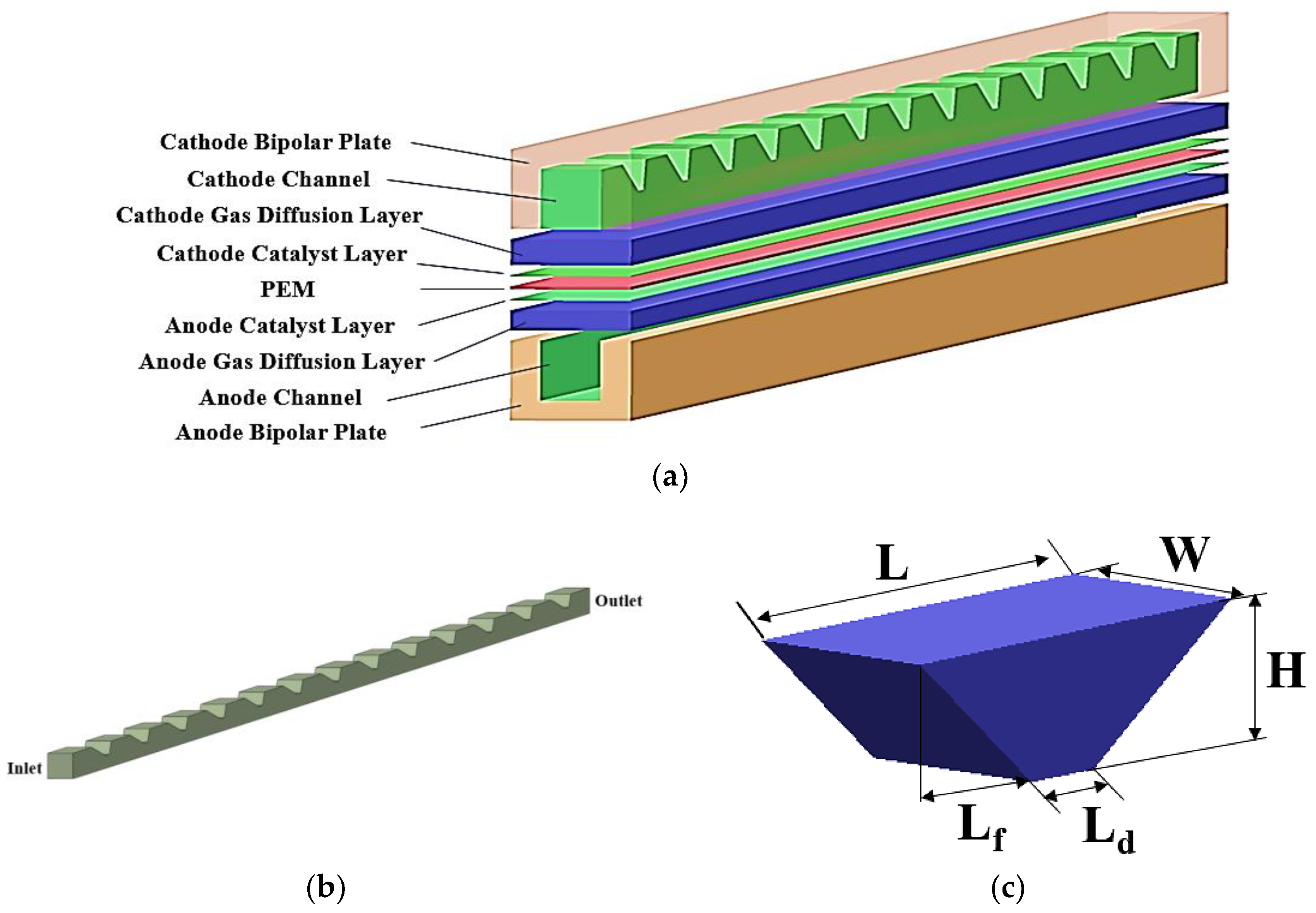

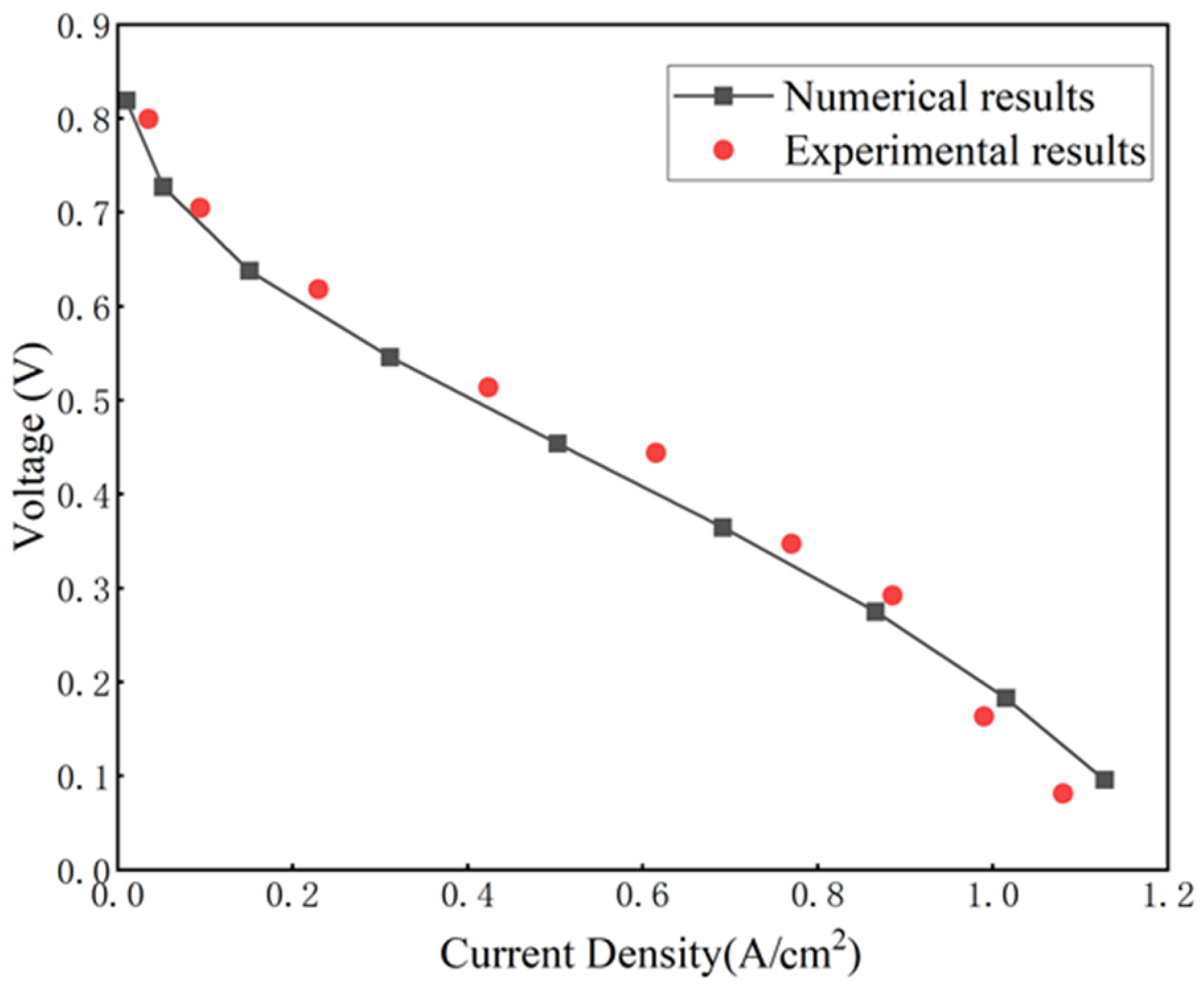
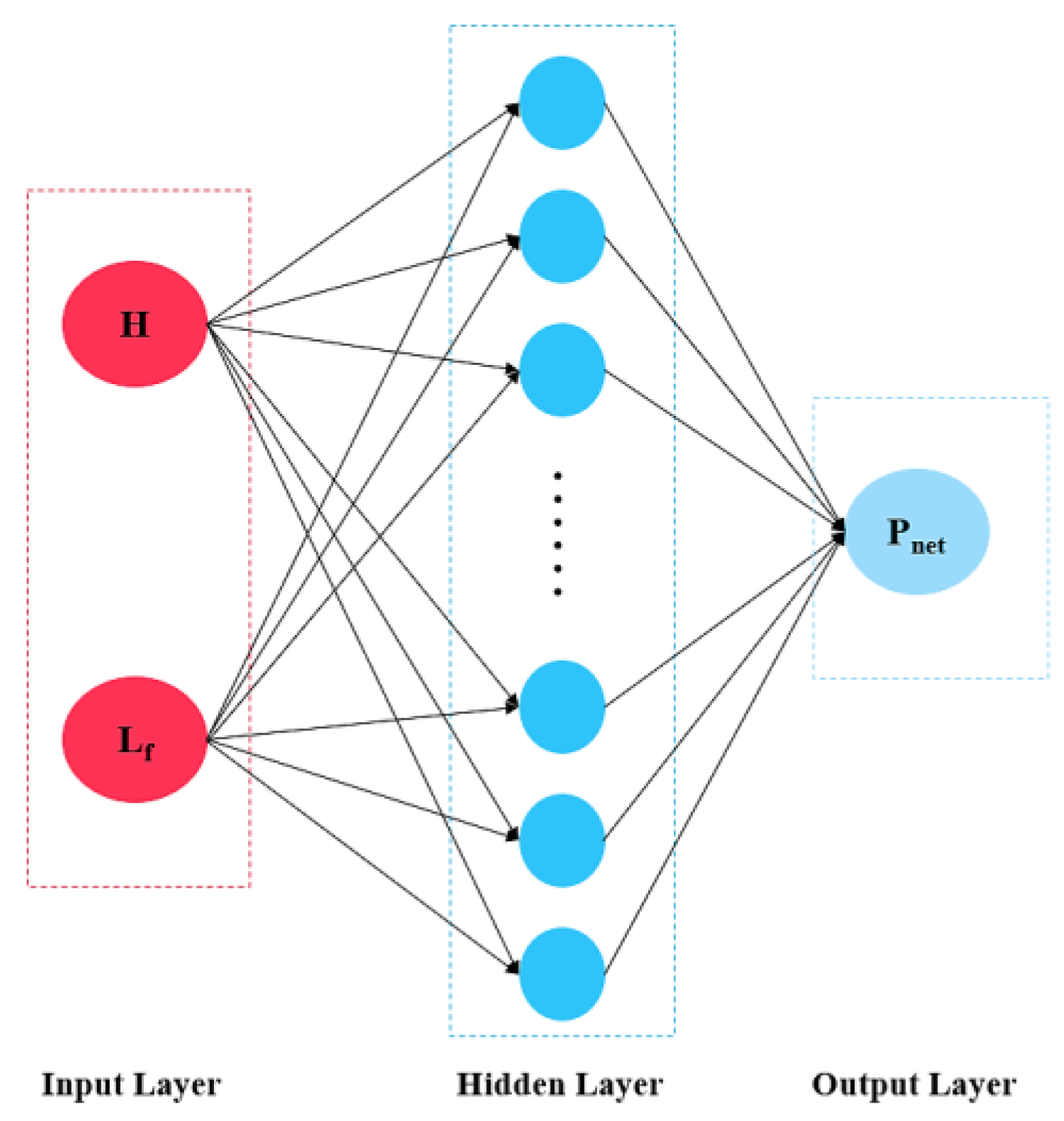
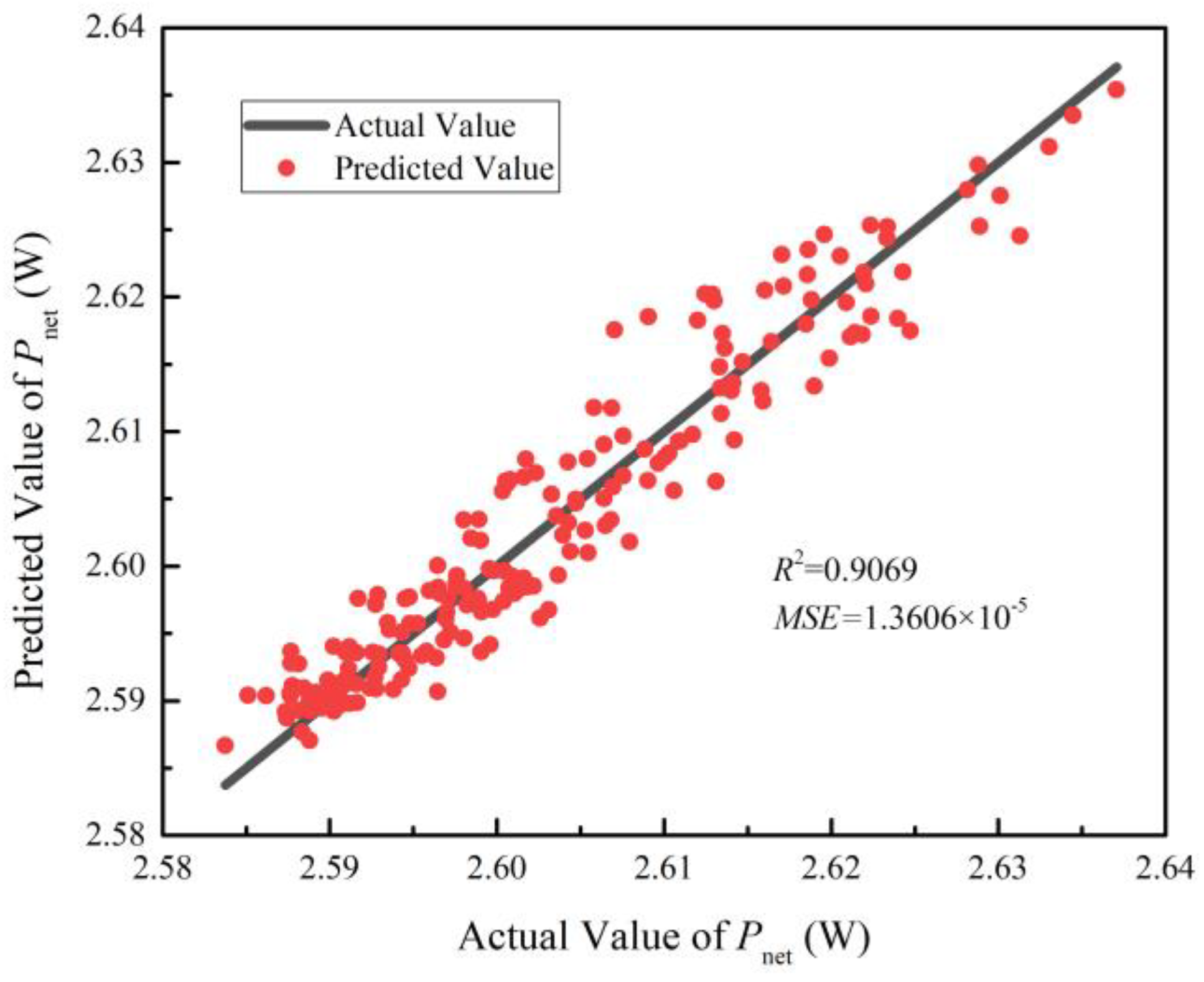
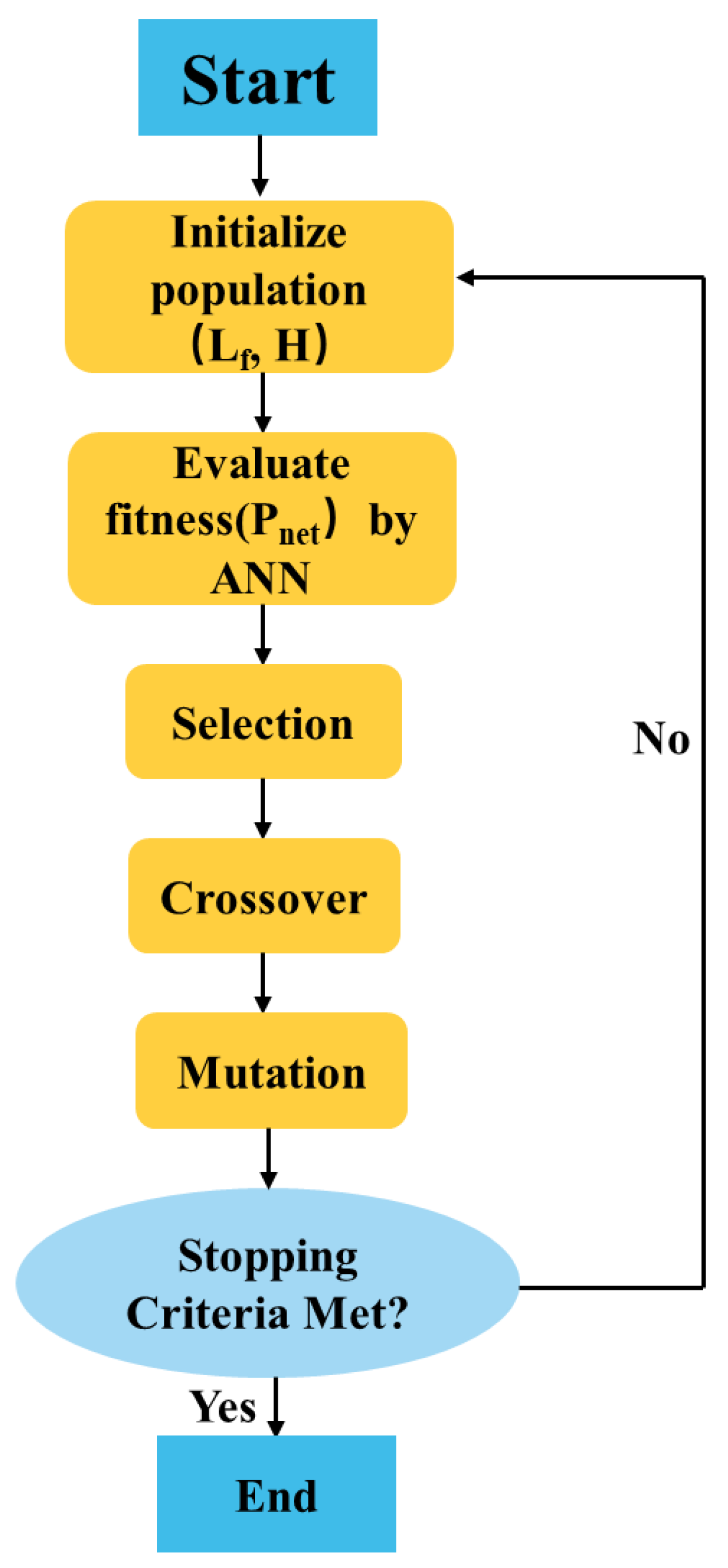

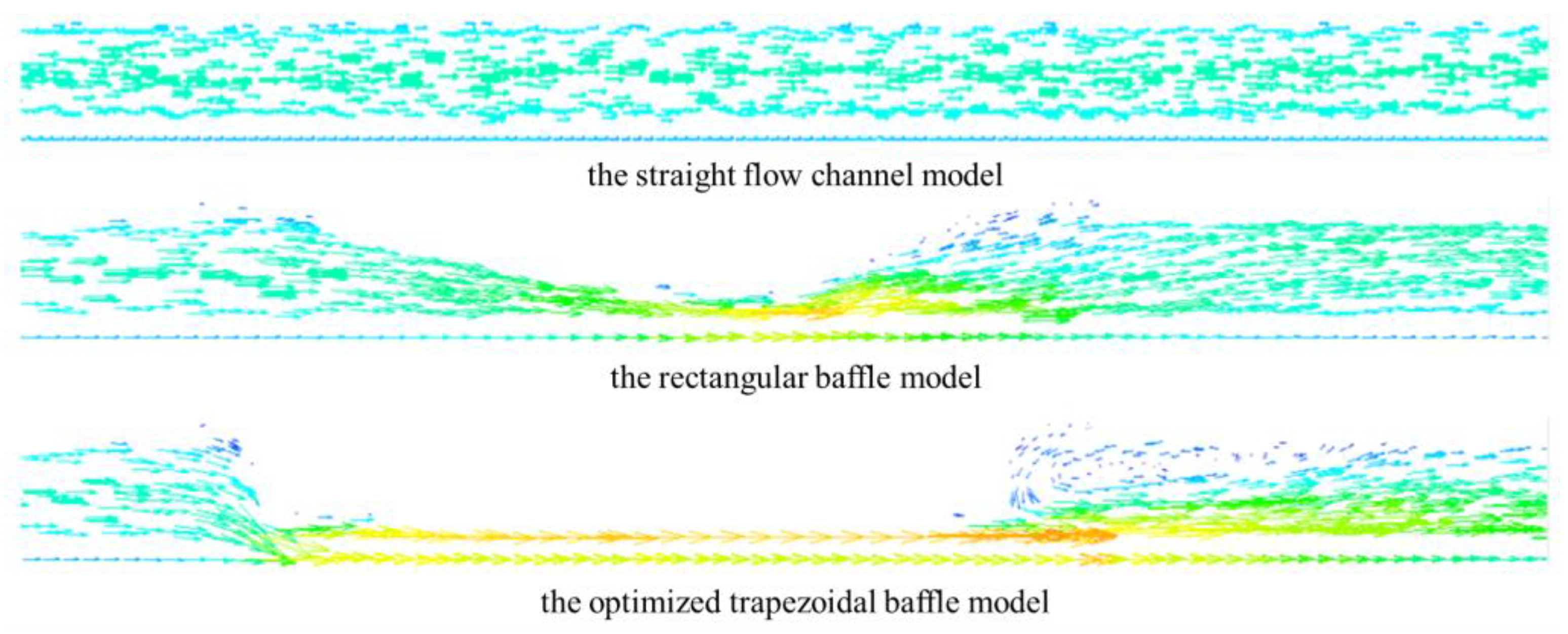


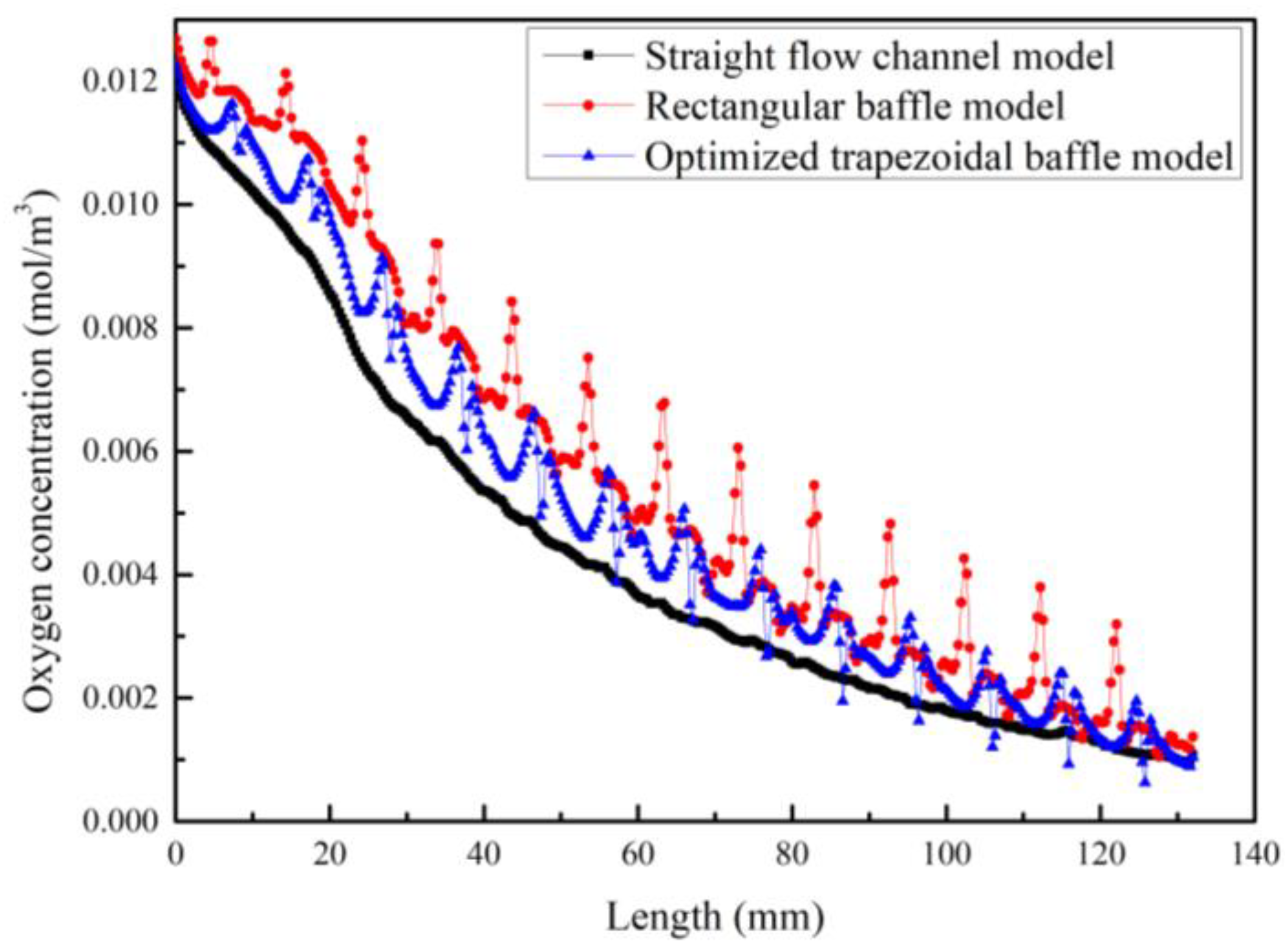


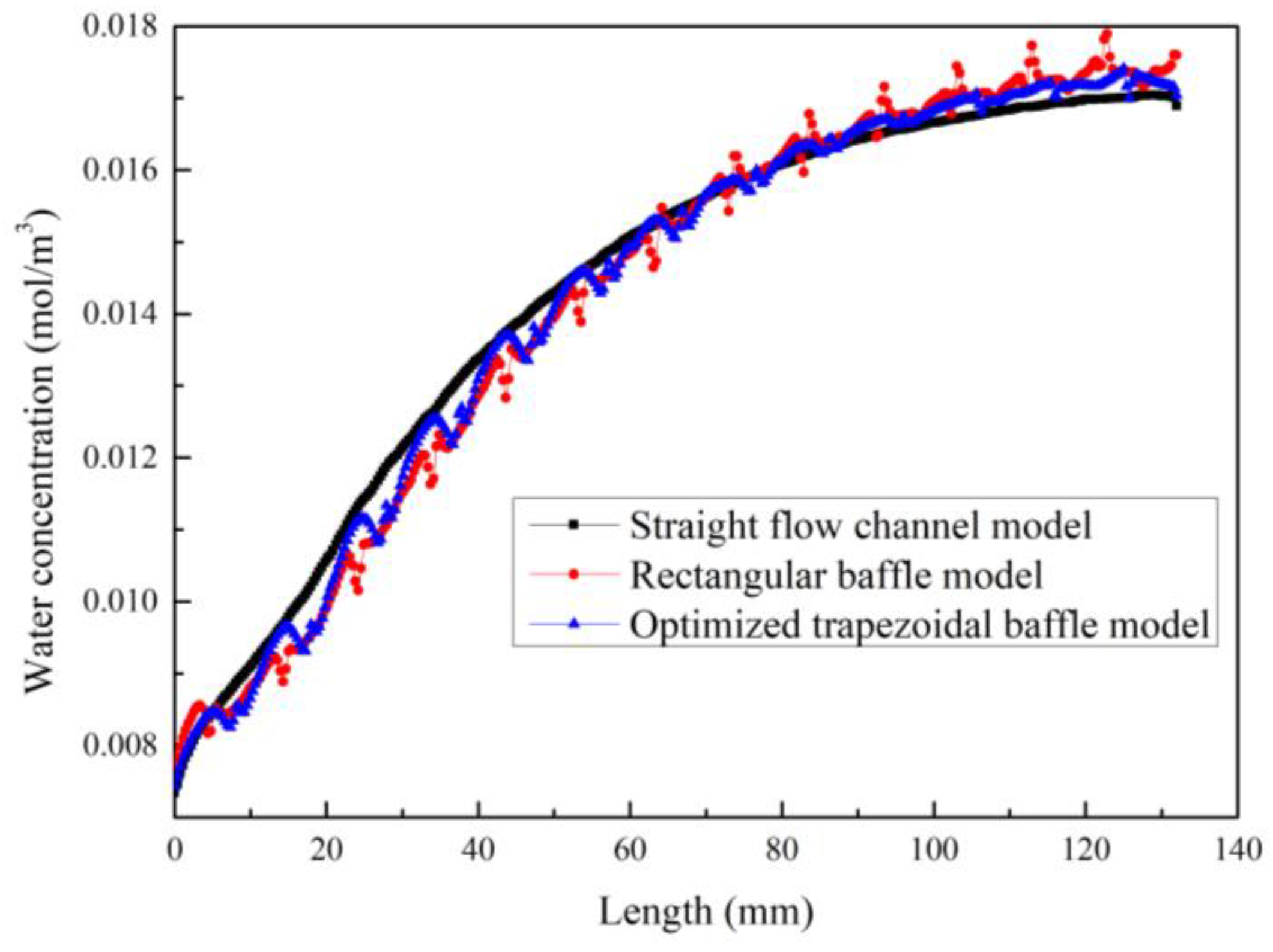


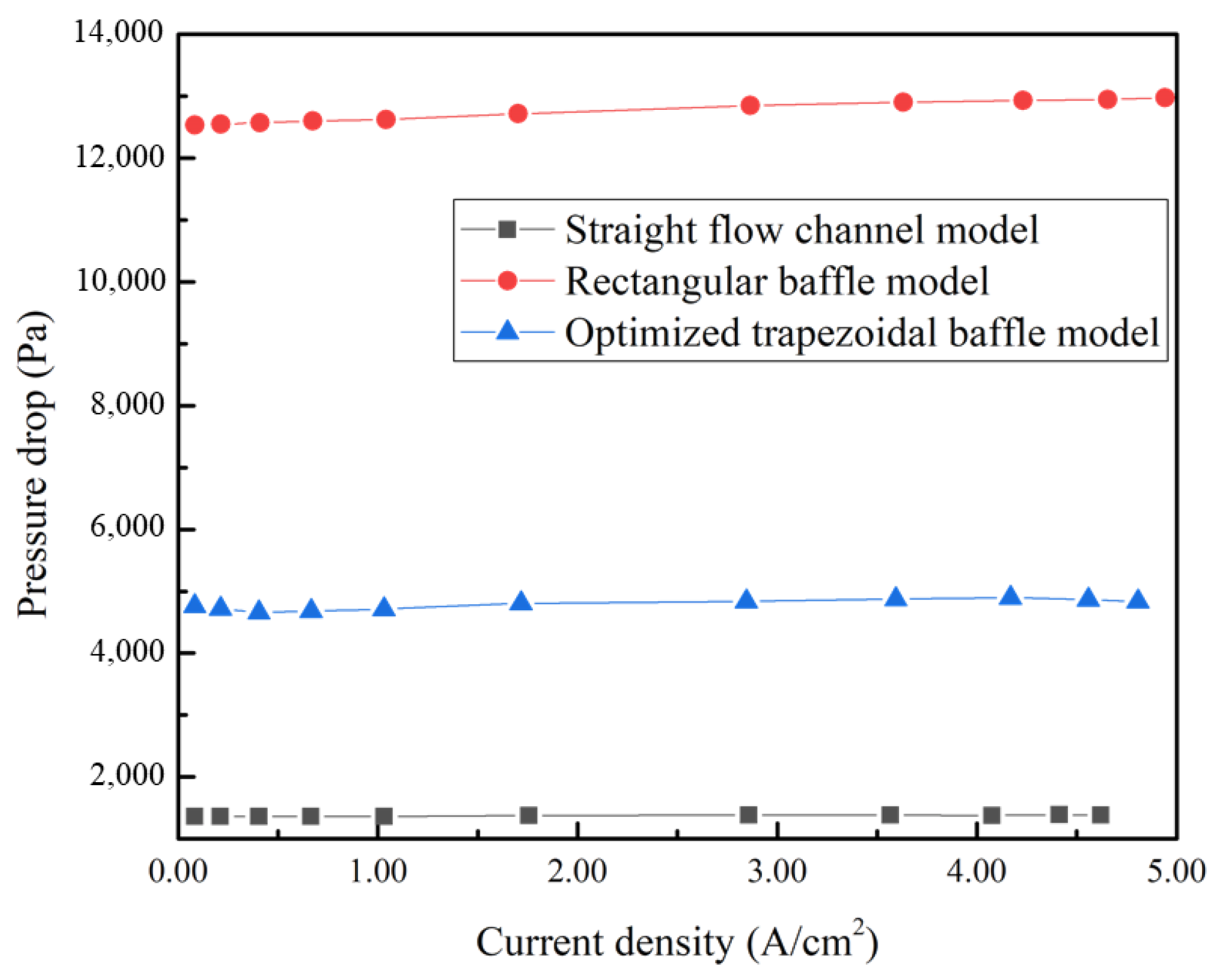

| Parameters | Values | Unit |
|---|---|---|
| Active area | 1.2 × 132 | mm × mm |
| Thickness of BP | 0.8 | mm |
| Thickness of GDL | 0.26 | mm |
| Thickness of CL | 0.01 | mm |
| Thickness of membrane | 0.03 | mm |
| Depth of flow channel | 0.6 | mm |
| Width of flow channel | 0.6 | mm |
| Parameters | Values | Unit |
|---|---|---|
| Width of baffles (W) | 0.6 | mm |
| Length of the upper base (L) | 5 | mm |
| Length of the lower base (Ld) | 1 | mm |
| Difference between L and Ld (Lf) | 2 | mm |
| Attitude of baffles (H) | 0.4 | mm |
| Parameters | Values | Unit | |
|---|---|---|---|
| Operation pressure | 200,000 | Pa | |
| Operation temperature | 343.15 | K | |
| Output voltage at optimization | 0.4 | V | |
| Open circuit voltage | 1.1 | V | |
| Electrical conductivity of BP | 1.0 × 106 | S/m | |
| Reference concentration | H2: 56.4 | O2: 3.39 | mol/m3 |
| Stoichiometry ratio | Anode: 1.5 | Cathode: 2 | - |
| Porosity of GDL | Anode: 0.4 | Cathode: 0.4 | - |
| Porosity of CL | Anode: 0.3 | Cathode: 0.3 | - |
| Electrical conductivity of GDL | Anode: 5000 | Cathode: 5000 | S/m |
| Relative humidity | Anode: 30% | Cathode: 50% | - |
| Reference exchange current density | Anode: 13000 | Cathode: 30 | A/m2 |
| Concentration exponent | Anode: 0.5 | Cathode: 1 | - |
| Case | Quantity of Grids | Current Density (A/cm2) |
|---|---|---|
| Case1 | 421,838 | 4.0918 |
| Case2 | 610,707 | 4.0769 |
| Case3 | 824,345 | 4.0828 |
| Case4 | 1,004,194 | 4.0808 |
| Case5 | 1,188,828 | 4.0717 |
| Parameters | Value or Setting |
|---|---|
| Training set | 70% |
| Test set | 15% |
| Verification set | 15% |
| Neuron number in input layer | 2 |
| Neuron number in hidden layer | 10 |
| Neuron number in output layer | 1 |
| Train function | Levenberg–Marquardt |
| Activation transfer function | Sigmoid |
| Parameters | Values |
|---|---|
| Population size | 50 |
| Evolution generation | 180 |
| Crossover fraction | 0.8 |
| Mutation fraction | 0.01 |
| Results | Values | Unit |
|---|---|---|
| Lf | 3.0344 | mm |
| H | 0.3999 | mm |
| Predicted net power density | 2.6357 | W/cm2 |
| Calculated net power density | 2.6294 | W/cm2 |
Disclaimer/Publisher’s Note: The statements, opinions and data contained in all publications are solely those of the individual author(s) and contributor(s) and not of MDPI and/or the editor(s). MDPI and/or the editor(s) disclaim responsibility for any injury to people or property resulting from any ideas, methods, instructions or products referred to in the content. |
© 2024 by the authors. Licensee MDPI, Basel, Switzerland. This article is an open access article distributed under the terms and conditions of the Creative Commons Attribution (CC BY) license (https://creativecommons.org/licenses/by/4.0/).
Share and Cite
Zhang, G.; Wang, C.; Bai, S.; Li, G.; Sun, K.; Cheng, H. Improvement of Blocked Long-Straight Flow Channels in Proton Exchange Membrane Fuel Cells Using CFD Modeling, Artificial Neural Network, and Genetic Algorithm. Appl. Sci. 2024, 14, 428. https://doi.org/10.3390/app14010428
Zhang G, Wang C, Bai S, Li G, Sun K, Cheng H. Improvement of Blocked Long-Straight Flow Channels in Proton Exchange Membrane Fuel Cells Using CFD Modeling, Artificial Neural Network, and Genetic Algorithm. Applied Sciences. 2024; 14(1):428. https://doi.org/10.3390/app14010428
Chicago/Turabian StyleZhang, Guodong, Changjiang Wang, Shuzhan Bai, Guoxiang Li, Ke Sun, and Hao Cheng. 2024. "Improvement of Blocked Long-Straight Flow Channels in Proton Exchange Membrane Fuel Cells Using CFD Modeling, Artificial Neural Network, and Genetic Algorithm" Applied Sciences 14, no. 1: 428. https://doi.org/10.3390/app14010428
APA StyleZhang, G., Wang, C., Bai, S., Li, G., Sun, K., & Cheng, H. (2024). Improvement of Blocked Long-Straight Flow Channels in Proton Exchange Membrane Fuel Cells Using CFD Modeling, Artificial Neural Network, and Genetic Algorithm. Applied Sciences, 14(1), 428. https://doi.org/10.3390/app14010428





